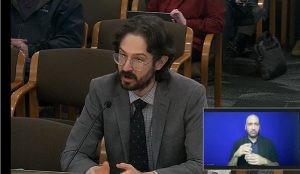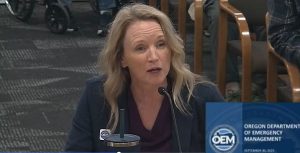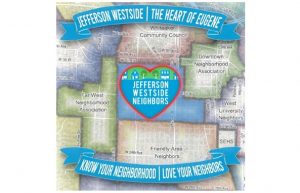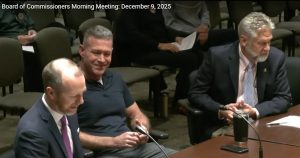Shelter work group asks legislature to extend funding to safe camping sites
6 min read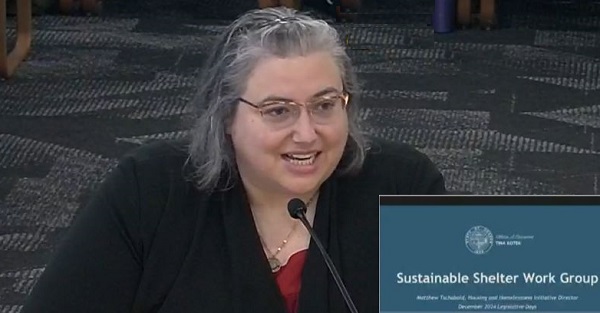
Presenter: A state work group recommends extending shelter funds to Eugene’s safe camping sites. On Dec. 11, at the House Interim Committee on Housing and Homelessness, Rep. Pam Marsh:
Rep. Pam Marsh: In our September legislative days, we had an information session on work undertaken around shelter sustainability. The state has done tremendous work since really 2020 on developing the shelter system. We funded Project Turnkey, we funded navigation centers, we had a governor’s emergency order which resulted in development of many more shelter beds.
[00:00:32] But we’ve realized that we’ve really done this work on an opportunistic basis. All of those programs have different funding streams. They have different expectations. They have different ways, different things that they can cover and different ways of getting the money to community.
[00:00:47] As we look forward, we can see that while we are making progress (I think) on the homelessness front, we are going to continue to need to have a robust shelter system that pulls people off the street and that moves them toward permanent stability and housing.
[00:01:03] Presenter: A shelter work group was formed. Rep. Pam Marsh:
[00:01:06] Rep. Pam Marsh: And we asked them to look at really three big questions. One was: What should the state be funding, what services should be in the universe of things that can qualify for state funding?
[00:01:17] We also asked them to look at how we should get funding to communities. We’ve used, frankly, different strategies for all the different funding sources so far. We’ve, in some cases, funded shelters directly. In other cases, we’ve handed money to communities and asked them to figure it out. So we asked this group, for the long term, what’s the right strategy and formula for getting shelter money to communities?
[00:01:38] And then we had a discussion about outcome expectations.
[00:01:42] So those were the questions that we asked. That group has been working pretty diligently over about four or five months and I’m very happy that Rep. (Vikki) Breese Iverson has been a part of that working group.
[00:01:53] And now we want to update you today on the status of the work. So you’re going to hear from people on the ground who do work around shelters on a daily basis. And I asked them to come and share with all of us their perspective on the work.
[00:02:08] Presenter: The governor’s Housing and Homelessness Initiative Director Matthew Tschabold:
[00:02:12] Matthew Tschabold: Matthew Tschabold with the Governor’s Office… So the work group itself was convened in the summer. They chose to break into three subgroups. One that was focused on reviewing how the state currently funds shelter and coming up with some recommendations on how that should look moving forward; what the state funding can go toward in terms of shelter facility type and services; and then a data and technical assistance subgroup, a more technical group around the data that we require be reported in order for us to be able to track client information and the outcome and impact of state programs.
[00:02:47] So that work has occurred and they have forwarded a set of recommendations to the full work group for final consideration. At the staff level, we’ve incorporated it into a report and then this will go to the governor, to Chair Marsh for consideration around what to establish in state statute for an ongoing state shelter program, and what then to establish in administrative rule and funding agreements.
[00:03:13] Presenter: Work group member from Lane County, Kate Budd:
[00:03:16] Kate Budd: My name is Kate Budd. I’m the Human Services Division Manager with Lane County government. Lane County has the unique privilege of serving as the regional Community Action Agency, the Homelessness Management Information System or HMIS administrator, and the HUD-designated Continuum of Care. This means we are the regional coordinator for addressing homelessness and poverty across our community. I appreciated having a seat in the shelter work group and representing regional coordination.
[00:03:48] One of the greatest strengths of the policies coming out of the work group is the recognition of the value of a regionally coordinated homeless shelter system. Lane County has over 1,000 emergency shelter beds supporting, supported by over 20 different privately- and publicly-funded agencies. With such a large scope of services, it is incredibly important that there be a local entity coordinating and funding across those agencies through a 50,000-foot lens.
[00:04:19] Another strength of the workgroup was identifying the outcomes, not outputs, each shelter should be striving to achieve and HMIS to reduce the burden on shelter staff and residents. This conversation also prioritized progressing equity across the shelter system and identified outcomes to track and disaggregate based on demographics to make sure persons of color are not being disproportionately affected by shelter policies.
[00:04:50] The work group also concluded EHA (Emergency Housing Account) and SHAP (State Homeless Assistance Program) funds ought to remain flowing through the community action agencies. Lane County is in support of this approach. These long-standing funding sources are often described as the glue which makes programming possible for our nonprofit partners and leverages state and federal funding sources.
[00:05:13] EHA is extraordinarily flexible and supports a wide array of programming beyond emergency shelter. To change the flow of that funding source, as well as SHAP, would be a detriment to our current system of service provisions within the community.
[00:05:30] Looking into the future, I greatly encourage the state to take its work around emergency shelter and zoom out to look at the full array of homeless crisis response system programs funded through state entities. This includes prevention, rapid rehousing, permanent supported housing, and street outreach. The opportunity is to examine how the impact of those programs, including the emergency shelter work done this summer, can be heightened when well coordinated together and across our various systems of care.
[00:06:04] How can the state provide the greatest level of flexibility and support in a culturally-responsive, trauma-informed, centered, efficient system that effectively transitions households from homelessness to permanent housing and long term stability?
[00:06:18] I envision a statewide homelessness framework.
[00:06:21] Presenter: Responding to questions from the committee, Kate Budd:
[00:06:25] Kate Budd: I think the strength of the work is that it’s taken the scope of what can be funded and expanded it considerably, and so that includes the creative solutions that both Lane County and the city of Eugene have been funding through nonstate funds. And so I very much think that will be an outcome of this process.
[00:06:45] I think that looking at rapid rehousing and the way that we are moving people from emergency shelter and the street into permanent housing is an opportunity. The state does a great deal of work around permanent supported housing and it’s been an incredible asset to our communities.
[00:07:04] But how do we also utilize rapid rehousing and diversion and other ways that we’re transitioning folks out of homelessness in the most comprehensive way as we can, and also marry that with the HRSN (Health Related Social Needs) housing benefit, that we are continuing to move forward across the state.
[00:07:23] Presenter: She was asked about obstacles to getting people into housing. Kate Budd:
[00:07:28] Kate Budd: There’s many reasons, of course, and I think our providers would firstly point to the very low vacancy rate that we have across Lane County, but is across the state in general, and so that greatly limits the options available to our community members who are unhoused.
[00:07:46] I think the opportunity to move past that barrier is being as creative as possible. Block leasing takes the challenge of finding housing away from the client and instead allows agencies to have units readily available when a client is able to move out of houselessness. So that’s been a great way to break through that barrier.
[00:08:12] Another way that we’ve done that statewide is providing the Landlord Mitigation Fund. And we’ve seen in Lane County that has motivated landlords to get involved and to recognize that their risk is greatly mitigated and we’ve seen that landlords are willing to step forward and say, ‘Yes, we’re interested in partnering with an agency that is rehousing someone,’ and even to the point where they’ve offered if someone moves out to provide their housing again to the program to place someone in.
[00:08:46] So that’s created a pipeline of housing options available to folks that we didn’t have prior to the executive order.
[00:08:54] Presenter: Lane County’s Kate Budd speaks during December legislative days about the sustainable shelter work group. The Oregon legislature will take up those recommendations in the 2025 session.
